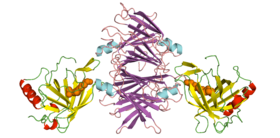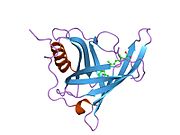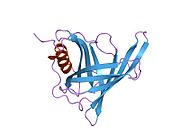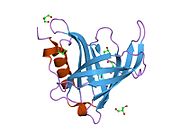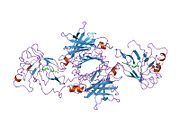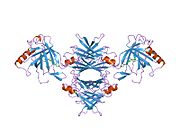Biology:Retinol binding protein 4
 Generic protein structure example |
Retinol binding protein 4, also known as RBP4, is a transporter protein[1] for retinol (vitamin A alcohol). RBP4 has a molecular weight of approximately 21 kDa and is encoded by the RBP4 gene in humans.[2][3] It is mainly, though not exclusively, synthesized in the liver and circulates in the bloodstream as a hepatokine bound to retinol in a complex with transthyretin. RBP4 has been a drug target for ophthalmology research due to its role in vision.[4] RBP4 may also be involved in metabolic diseases as suggested by recent studies.
Function
This protein belongs to the lipocalin family and is the specific carrier for retinol (vitamin A) in the blood. It delivers retinol from the liver stores to the peripheral tissues. In plasma, the RBP-retinol complex interacts with transthyretin, which prevents its loss by filtration through the kidney glomeruli. A deficiency of vitamin A blocks secretion of the binding protein posttranslationally and results in defective delivery and supply to the epidermal cells.[3]
Structure
RBP4 is a single polypeptide chain with a hydrophobic pocket where retinol binds. The RBP4-retinol complex then binds transthyretin in circulation to prevent renal filtration of RBP4.[5]
In serum, TTR and RBP4 bind in a 1 to 1 stoichiometry (two molecules of TTR combine with two molecules of RBP4 to form a complex with a total molecular weight of approximately 80,000 daltons).[6]
Clinical significance
Retinol-binding protein 4 has been a drug target for eye diseases as RBP4 is the sole carrier for retinol, which is an essential nutrient for the visual cycle. Animal studies using RBP4-antagonists showed that lowering RBP4 can lead to reduction in the accumulation of lipofuscin that leads to vision loss in eye diseases like Stargardt's disease and macular degeneration.[4][7] An animal study using ABCA4 knockout mouse proved that reduction in serum RBP4 level could inhibit lipofuscin without inhibiting the visual cycle.[ref] One clinical study in age-related macular degeneration (AMD) was conducted using Fenretinide. The study showed trends in reducing lesion growth rate in AMD and rate of conversion from early stage AMD (dry AMD) to late stage AMD (wet AMD) without serious side effects.
RBP4 has recently been described as an adipokine that contributes to insulin resistance and diabetes in the AG4KO mouse model.[8] In addition to the liver, RBP4 is also secreted by adipocytes of the fat tissue in a smaller portion and acts as a signal to surrounding cells, when there is a decrease in plasma glucose concentration.[9] It is suspected that an elevated level of RBP4 attracts macrophages to the fat tissue, causes local inflammation, and leads to insulin resistance.[10][11]
Mutations in the RBP4 gene have recently been linked to a form of autosomal dominant microphthalmia, anophthalmia, and coloboma (MAC) disease.[12] A unique feature of this disease is the maternal inheritance effect, when a fetus inherits a mutated copy of the RBP4 gene from its mother, but not from its father. The physiologic basis lies in pregnancy whereby the mutated gene product, retinol binding protein (RBP), has negative effects in transferring vitamin A from maternal liver storage sites to the placenta, and then again on the fetal circulation side when delivering vitamin A from the placenta to developing fetal tissues, most notably the developing eye. This 'double whammy' effect does not exist when the mutant RBP4 gene is inherited from the father. The above mechanism is separate from previously known types of maternal inheritance effects such as genomic imprinting, mitochondrial inheritance, or maternal oocyte mRNA transfer. The authors of the above study cite the potential of vitamin A supplementation in pregnant females who are known to carry an RBP4 mutation with retinyl ester which utilizes an RBP-independent pathway to deliver retinoids from the maternal intestines directly to the placenta and ultimately is uptaken by the fetus. The key would be to supplement during the first several months of life when the eye begins to develop, as supplementing later in pregnancy would be too late to avoid any potential MAC disease.
See also
References
- ↑ "The complete amino acid sequence of human serum retinol-binding protein". Upsala Journal of Medical Sciences 92 (2): 115–46. 1987. doi:10.3109/03009738709178685. PMID 2444024.
- ↑ "Regional mapping of RBP4 to 10q23----q24 and RBP1 to 3q21----q22 in man". Somatic Cell and Molecular Genetics 15 (2): 185–90. March 1989. doi:10.1007/BF01535081. PMID 2928844.
- ↑ 3.0 3.1 "Entrez Gene: RBP4 retinol binding protein 4, plasma". https://www.ncbi.nlm.nih.gov/sites/entrez?Db=gene&Cmd=ShowDetailView&TermToSearch=5950.
- ↑ 4.0 4.1 "Design, synthesis, and evaluation of nonretinoid retinol binding protein 4 antagonists for the potential treatment of atrophic age-related macular degeneration and Stargardt disease" (in EN). Journal of Medicinal Chemistry 57 (18): 7731–57. September 2014. doi:10.1021/jm5010013. PMID 25210858.
- ↑ "Retinol-binding protein: the transport protein for vitamin A in human plasma". The Journal of Clinical Investigation 47 (9): 2025–44. September 1968. doi:10.1172/jci105889. PMID 5675424.
- ↑ "The structure of human retinol-binding protein (RBP) with its carrier protein transthyretin reveals an interaction with the carboxy terminus of RBP". Biochemistry 38 (9): 2647–53. March 1999. doi:10.1021/bi982291i. PMID 10052934.
- ↑ "Reductions in serum vitamin A arrest accumulation of toxic retinal fluorophores: a potential therapy for treatment of lipofuscin-based retinal diseases". Investigative Ophthalmology & Visual Science 46 (12): 4393–401. December 2005. doi:10.1167/iovs.05-0820. PMID 16303925.
- ↑ "Serum retinol binding protein 4 contributes to insulin resistance in obesity and type 2 diabetes". Nature 436 (7049): 356–62. July 2005. doi:10.1038/nature03711. PMID 16034410. Bibcode: 2005Natur.436..356Y.
- ↑ "Glucose transport and sensing in the maintenance of glucose homeostasis and metabolic harmony". The Journal of Clinical Investigation 116 (7): 1767–75. July 2006. doi:10.1172/JCI29027. PMID 16823474.
- ↑ "RBP4 activates antigen-presenting cells, leading to adipose tissue inflammation and systemic insulin resistance". Cell Metabolism 19 (3): 512–26. March 2014. doi:10.1016/j.cmet.2014.01.018. PMID 24606904.
- ↑ "Adipose tissue as an endocrine organ". Molecular and Cellular Endocrinology 316 (2): 129–39. March 2010. doi:10.1016/j.mce.2009.08.018. PMID 19723556.
- ↑ "Biochemical Basis for Dominant Inheritance, Variable Penetrance, and Maternal Effects in RBP4 Congenital Eye Disease". Cell 161 (3): 634–646. April 2015. doi:10.1016/j.cell.2015.03.006. PMID 25910211.
Further reading
- "Understanding the physiological role of retinol-binding protein in vitamin A metabolism using transgenic and knockout mouse models". Molecular Aspects of Medicine 24 (6): 421–30. December 2003. doi:10.1016/S0098-2997(03)00038-4. PMID 14585313.
- "Plasma retinol binding protein: structure and function of the prototypic lipocalin". Biochimica et Biophysica Acta (BBA) - Protein Structure and Molecular Enzymology 1482 (1–2): 57–64. October 2000. doi:10.1016/s0167-4838(00)00150-3. PMID 11058747.
- "Retinol-binding protein from human urine and its interaction with retinol and prealbumin". European Journal of Biochemistry 94 (1): 307–13. February 1979. doi:10.1111/j.1432-1033.1979.tb12896.x. PMID 571335.
- "The primary structure of the human retinol-binding protein". FEBS Letters 104 (1): 55–8. August 1979. doi:10.1016/0014-5793(79)81084-4. PMID 573217.
- "Interaction between prealbumin and retinol-binding protein studied by affinity chromatography, gel filtration and two-phase partition". European Journal of Biochemistry 99 (2): 353–60. September 1979. doi:10.1111/j.1432-1033.1979.tb13263.x. PMID 574085.
- "Three-dimensional structure and active site of three hydrophobic molecule-binding proteins with significant amino acid sequence similarity". Biopolymers 32 (4): 457–65. April 1992. doi:10.1002/bip.360320425. PMID 1623143.
- "Crystallographic refinement of human serum retinol binding protein at 2A resolution". Proteins 8 (1): 44–61. 1990. doi:10.1002/prot.340080108. PMID 2217163.
- "Structure and cell-specific expression of a cloned human retinol binding protein gene: the 5'-flanking region contains hepatoma specific transcriptional signals". The EMBO Journal 4 (8): 1981–9. August 1985. doi:10.1002/j.1460-2075.1985.tb03881.x. PMID 2998779.
- "Membrane receptors for retinol-binding protein in cultured human retinal pigment epithelium". Investigative Ophthalmology & Visual Science 27 (7): 1031–40. July 1986. PMID 3013795.
- "Immunohistochemical localization of plasma retinol-binding protein and prealbumin in human pancreatic islets". The Histochemical Journal 18 (4): 164–8. April 1986. doi:10.1007/BF01676116. PMID 3525470.
- "Loss of retinol-binding properties for plasma retinol-binding protein in normal human epidermis". The Journal of Investigative Dermatology 88 (4): 403–8. April 1987. doi:10.1111/1523-1747.ep12469731. PMID 3559267.
- "Studies on two physiological forms of the human retinol-binding protein differing in vitamin A and arginine content". The Journal of Biological Chemistry 246 (21): 6638–46. November 1971. doi:10.1016/S0021-9258(19)34162-6. PMID 5132677.
- "Cloning and sequencing of a full length cDNA coding for human retinol-binding protein". Nucleic Acids Research 11 (22): 7769–76. November 1983. doi:10.1093/nar/11.22.7769. PMID 6316270.
- "The three-dimensional structure of retinol-binding protein". The EMBO Journal 3 (7): 1451–4. July 1984. doi:10.1002/j.1460-2075.1984.tb01995.x. PMID 6540172.
- "Structural and functional studies of vitamin A-binding proteins". Annals of the New York Academy of Sciences 359 (1): 79–90. February 1981. doi:10.1111/j.1749-6632.1981.tb12739.x. PMID 6942701. Bibcode: 1981NYASA.359...79R.
- "Characterization of two post-translationally processed forms of human serum retinol-binding protein: altered ratios in chronic renal failure". Journal of Lipid Research 36 (6): 1247–53. June 1995. doi:10.1016/S0022-2275(20)41132-0. PMID 7666002.
- "The Ile-84-->Ser amino acid substitution in transthyretin interferes with the interaction with plasma retinol-binding protein". The Journal of Biological Chemistry 269 (38): 23395–8. September 1994. doi:10.1016/S0021-9258(17)31527-2. PMID 8089102.
- "Phenotype in retinol deficiency due to a hereditary defect in retinol binding protein synthesis". Investigative Ophthalmology & Visual Science 40 (1): 3–11. January 1999. PMID 9888420.
External links
- RBP4+protein,+human at the US National Library of Medicine Medical Subject Headings (MeSH)
- Overview of all the structural information available in the PDB for UniProt: P02753 (Retinol-binding protein 4) at the PDBe-KB.
 |
